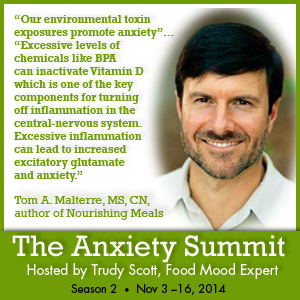Tom A. Malterre, MS, CN author of Nourishing Meals: Healthy Gluten-Free Recipes for the Whole Family was interviewed by host of the Anxiety Summit, Trudy Scott, Food Mood Expert and Nutritionist, author of The Antianxiety Food Solution.
Our environmental toxin exposures promote anxiety
- The drastic spike in ADD/ADHD and autism and increase in anxiety and depression
- Air pollution as an environmental toxin: concerns and sources (mercury, the brown cloud)
- Mercury in fish and fish meal for animals
- EDCs/ Endocrine Disrupting Compounds: BPA, phthalates and anxiety
- Pesticides and the effects on folates in the colon and the production of serotonin
- TILT /Toxicant-induced loss of tolerance
- What to do: nutritional and lifestyle tips
Here are the quotes from The Journal of Environmental Health paper co-written by Dr. Steven Genuis:
Toxicity and nutritional deficiency states often receive insufficient attention as common source causes of chronic disease in the developed world
it’s evident that a reevaluation of conventional wisdom on the current construct of disease origins should be considered
Here are some snippets from our interview:
Now 74 billion pounds of chemicals are being imported or produced in the United States every single day, that doesn’t include pharmaceuticals, it doesn’t include fuels and food additives. It doesn’t include some of the primary things like pesticides that we’re exposed to on a daily basis so that number is conservative and still, to me, it’s completely and totally overwhelming
Excessive levels of chemicals like BPA can inactivate Vitamin D which is one of the key components for turning off inflammation in the central-nervous system. Excessive inflammation can lead to increased excitatory glutamate and anxiety.
Here is the 2012 study co-authored by Stephen Genuis: Human Excretion of Bisphenol A: Blood, Urine, and Sweat (BUS) Study
Biomonitoring of BPA through blood and/or urine testing may underestimate the total body burden of this potential toxicant. Sweat analysis should be considered as an additional method for monitoring bioaccumulation of BPA in humans. Induced sweating appears to be a potential method for elimination of BPA.
The Environmental Working Group SkinDeep site is a great resource for checking out safe cosmetics
Here is some of the research on Vitamin D and inflammation that is being conducted by Colleen Hayes and colleagues
If you are interested in learning more about broccoli’s superhero powers, watch Tom’s TED talk here on YouTube! “Broccoli – the DNA whisperer”
Cauliflower is also a good source of sulforaphane and here is a yummy Coconut lemon garlic cauliflower recipe from one of Tom’s books Nourishing Meals: Healthy Gluten-Free Recipes for the Whole Family.
If you are not already registered for the Anxiety Summit you can get live access to the speakers of the day here www.theAnxietySummit.com
